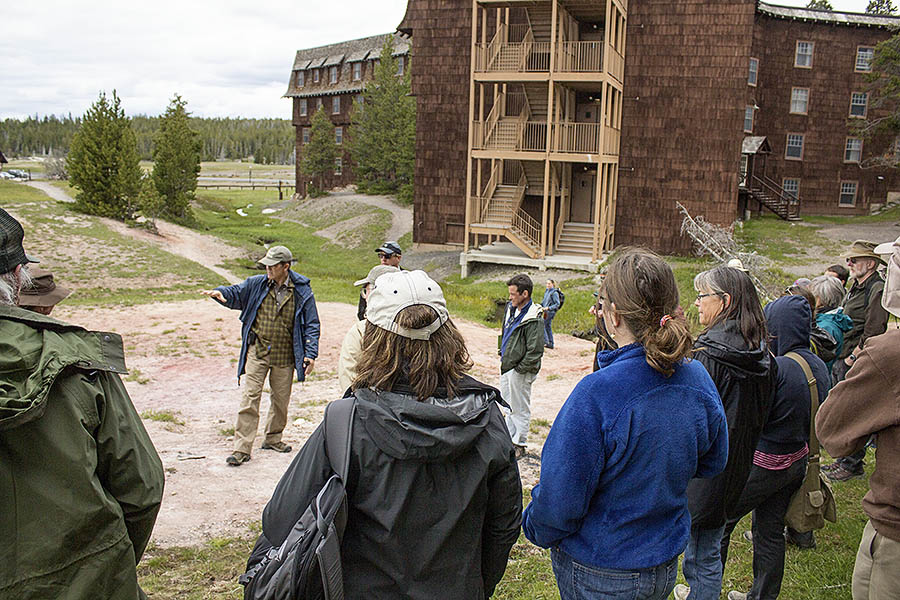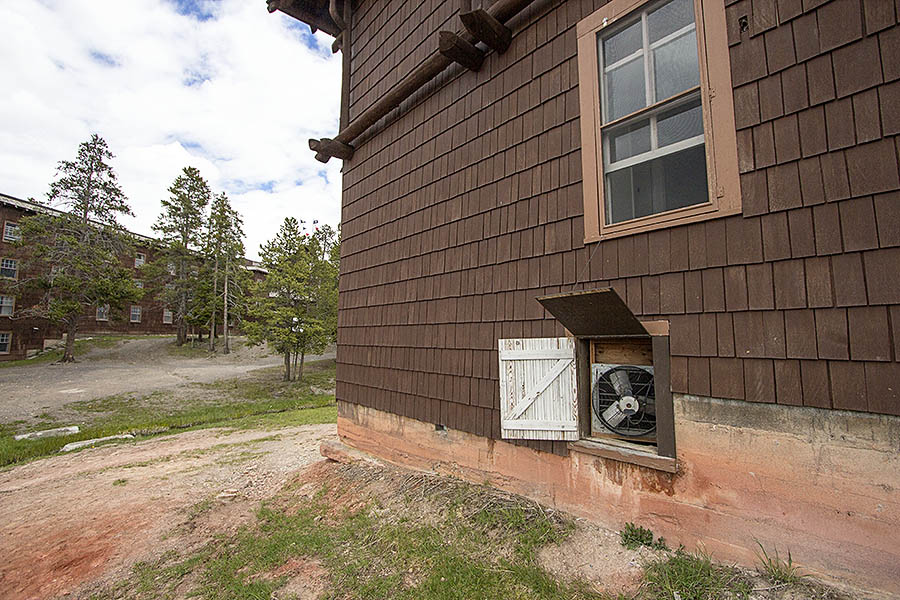
Yellowstone National Park geologist Hank Heasler gestures while explaining to a group of science conference attendees some of the complications of building around the Old Faithful area. (Janet White/GeyserWatch.com)
By Janet White
For those of us who are of a certain age, we remember the days in Yellowstone National Park when a black bear sighting meant almost every passing car would stop to feed the bear begging by the side of the road. It was especially fun to see cubs scarf down marshmallows and other items from the picnic basket, even though we knew it wasn’t remotely close to how they should behave in the wild.
 We also might remember the excitement around the reintroduction of gray wolves to Yellowstone in 1995, which began to reverse the long-standing effects of much earlier efforts to exterminate wolves in Yellowstone and surrounding areas. And how rare it used to be to even get a glimpse at a grizzly bear before that animal began to recover thanks to increased protections.
We also might remember the excitement around the reintroduction of gray wolves to Yellowstone in 1995, which began to reverse the long-standing effects of much earlier efforts to exterminate wolves in Yellowstone and surrounding areas. And how rare it used to be to even get a glimpse at a grizzly bear before that animal began to recover thanks to increased protections.
Many changes have come about in how Yellowstone has been managed since those days. The management of Yellowstone, as well as other national parks, is guided by the Organic Act of 1916, which puts forth potentially conflicting directives:
“….to conserve the scenery and the natural and historic objects and the wildlife therein and to provide for the enjoyment of the same in such manner and by such means as will leave them unimpaired for the enjoyment of future generations.”
So that means enabling visitors to see the “wonders,” and yet protecting them from harm by the millions who come to see them. Not an easy balance to reach, but one that has driven so many changes. To help reach a logical balance, park managers are increasingly relying on science to help them when making decisions.
Earlier this month, a panel of leading experts gathered to review the science behind what drives the park’s hydrothermal habitats and examine how to better manage the Old Faithful area, where historic buildings sit on warm and sometimes changing ground.
If the Old Faithful area were not already developed, its management would be much easier, without issues such as whether to move old buildings from unstable spots or build new structures in a crowded hot zone. But the Old Faithful village does exist, and going back in time isn’t an option. We can only keep moving forward. So by looking closer at what we know, what issues exist and what other information is still needed, managers hope to use science to help make better decisions about the future.
The review panel gave an overview of what is known about hydrothermal habitats and what scientific information is still needed to help managers find the right answers to the issues at hand, including how to manage existing development and where or whether to create new structures around Old Faithful.
A lesson from New Zealand
Geysers are rare and can be affected by natural or man-made changes to their systems. Rick Allis, Utah state geologist, discussed changes he saw in hydrothermal systems in New Zealand after private efforts to tap geothermal energy there. Some large-scale landscapes and many individual features changed drastically or ceased functioning entirely after extensive drilling.
Yellowstone is not immune from human tampering with thermal areas. Park historian Lee Whittlesey detailed how early explorers, concessioners, visitors and even park employees often broke off souvenirs from mineral deposits around thermal features, or threw debris into geysers, including Old Faithful.
Experimental exploratory drilling in Yellowstone done in decades past gave some scientific insight. But it also directly altered some geysers and hot springs nearby.
A swimming pool located near Old Faithful between 1915-1949 was filled with hot water piped from Solitary Spring. Diversion of that water changed Solitary from a spring to a geyser by lowering the feature’s hydrostatic pressure. The pool was finally phased out after 1949, and water was no longer diverted from the spring. Solitary is still recovering from the human-caused changes.
Panel members also pointed out that that the Old Faithful hydrothermal habitat needs not only deep reservoirs of water, but also the shallower groundwater from rain and snow-melt to recharge the geysers and hot springs. Parking lots and asphalt are not permeable, so they alter the habitat by changing where the rain can find a path to soak into the ground. One potential suggestion from the panel was that future parking lots be made with gravel, rather than asphalt, allowing for improved permeability.
The infrastructure you see in the Old Faithful Village not only contains buildings and tanks above ground, but also a network of pipes and lines below ground. Historic buildings now sit on hot ground, with some basements acting to trap heat and gasses released by thermal processes. The effect is not unlike adding a lid to a pot of hot water, accelerating the heating process.
Historic hot spots

A fan helps cool the crawl space in the historic Laurel Dorm building at Old Faithful, as hot ground raises basement temperatures. (Janet White/GeyserWatch.com)
Yet these buildings are historic and have a value to those of us who visit. The Old Faithful Inn is designated as a National Historic Landmark, conveying the highest level of protection and priority for any structure. Such buildings require a management policy that preserves and protects while also allowing for enjoyment by millions of visitors. Many visitors have a distinct appreciation of the opportunity to be roused from sleep at night by an eruption of Beehive Geyser, or to dine in the historic Old Faithful Inn and then wander through the wonders of the Upper Geyser Basin on the boardwalks as the sun sets.
The review panel found that much work still needs to be done to learn more about how hydrothermal habitats function. The park service uses the latest infrared and mapping technology to help passively learn what lies below the surface. This helps greatly as a management tool, but more information is needed to gain an even larger picture.
Some panel discussions focused on finding ways to conduct more collaborative research that includes not only the National Park Service, but also the U.S. Geological Survey and perhaps other entities such as the Geyser Observation and Study Association and the newly forming citizen science project of GeyserTimes.org.
As science has changed how Yellowstone manages everything from trout to wolves to grizzly bears, it is obvious that hydrothermal habitats have a place on the list for more science-based management practices as well. It will be interesting to watch and see how that balance is found over the coming years.
Janet White is the creator of GeyserWatch.com and appreciates any reports on unusual or interesting activities by Yellowstone Park thermal features.
